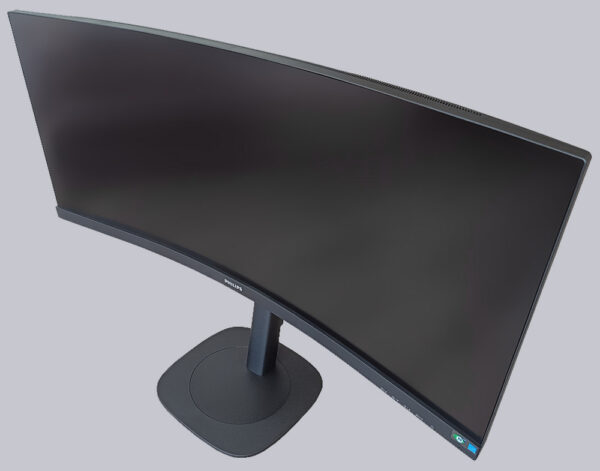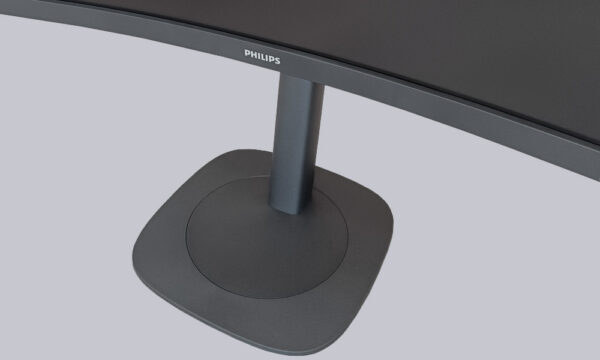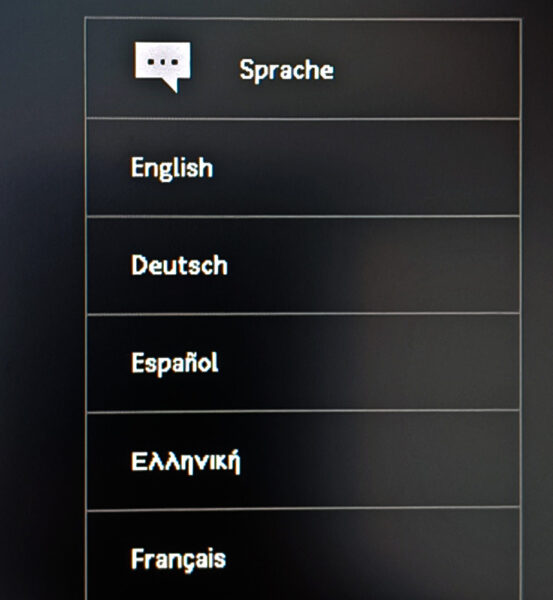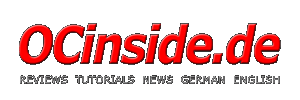
Practical testing …
At just under 8 kg, the net weight without the stand is roughly equivalent to a load of laundry for an average washing machine. This is just about manageable for carefully lifting the device out of the packaging.

Assembly was straightforward, as the stone leg clicks into place and the thick screw on the stand can be easily screwed in. There is no reason to assume that the construction could become unstable, given the screen diagonal of 34 inches. The monitor was moved and turned several times for photo creation and gave the impression of being robust. A full 180 mm of height adjustment is possible. However, the SchwerWeight cannot pivot, which is understandable given the curved design and would probably look strange. Thanks to the 100×100 VESA mount, a monitor arm or wall mount can also be easily attached with short M4 screws, and the monitor can be secured with a Kensington lock.

Image sharpness …
At 110 ppi, the pixel density is high. If you sit a little closer to the monitor, you won’t be able to make out individual pixels with an UltraWide Quad HD resolution of 3440 x 1440 pixels. At a typical office seating distance, the display is therefore beautifully coherent and sharp.
Response time …
At 4 ms (gray to gray), gamers will definitely take notice. Only e-sports gamers will need to opt for faster models.
With regard to the refresh rate, it should be noted that 120 Hz can only be achieved via DisplayPort or USB-C (DP Alt Mode), but 100 Hz via HDMI is certainly sufficient for casual gaming. This is an impressive figure, given that the TFT is primarily intended for office use.
Gaming …
The VA panel does indeed deliver rich colors, and those who lean back a little further in their gaming chair need not worry about viewing angle dependency. The rich blue of the start screen remains unchanged even when viewed from above or below and appears less pale overall than on an older IPS monitor we have available. In addition, the display is not highly reflective.
Whether the curved design really draws the player more into the action is questionable. The shape may correspond more closely to the natural human field of vision than conventional solutions, but the screen content is still displayed in 2D and thus has a completely different effect than a room with corresponding depth.
In my personal opinion, the design is actually distracting in Excel spreadsheets, while it only slightly enhances immersion in games. This is also achieved by the large screen diagonal, because 34″ takes up a large part of the field of vision and the player quickly forgets their surroundings.

Brightness …
With a brightness of 300 cd/m², there is no cause for criticism, especially since the brightness distribution appears to be fairly uniform. The model appeared slightly brighter in places at the top left edge and a little too dark at the outer edges on the left and right, but this is no longer noticeable in a dynamic gaming world with different shadows and light sources.
Instead of distracting from the actual action with excessive lighting, the display is very discreet here. The controls on the bottom of the model are similar to those users are accustomed to from other brands. However, there is a less familiar button on the left. This is called SmartImage and offers image enhancements for seven different scenes, from Office to Photo to Off. Next to it are the Back button, Signal Source, Brightness, OSD, OK, and Power.

Monitor menu …
The monitor menu can be operated intuitively using the six buttons shown above. The signal source can also be selected very easily.

There is also a selection of options: Picture, PIP/PBP, Audio, Color, OSD Settings, USB Settings, Setup, and last but not least, Language Selection.

Philips 34B2U3600C Result and general impression …

